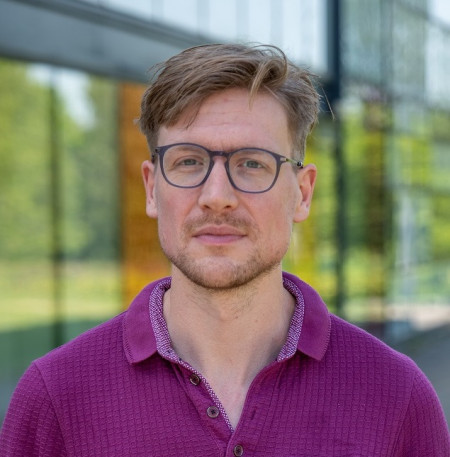
Dr Benjamin Dryer
Post Doctoral Research Fellow
Biography
Research interests
My research interests center around the design, development and operation of CCD and CMOS camera systems, with a focus on their application in the space environment and the image degradation that arises due to radiation damage. I am particularly interested in testing and developing cryogenic irradiation techniques, as well as investigating potential new technologies such as P-Channel CCDs. I have been involved in detector teams for ESA missions such as Gaia, Euclid, JUICE. Currently I am working on CASTOR, a Canadian Ultra-Violet Mission.
Teaching interests
I am passionate about teaching and currently serve as Chair of S818 Space Science. I am also an Associate Lecturer for the SM123 Physics and Space module. I have served on several module teams, including S217: Physics from Classical to Quantum and SXPS288: Remote Experiments in Physics and Space.
Impact and engagement
I am a passionate STEM ambassador, and enjoy interacting with local school, exhibitions, and the media. Some highlights include:
- Interviews on national television and radio
- Co-ordinating exhibits for the UK Space Conference and Royal Society Summer Science Exhibition
- Delivering public talks
- Delivering enrichment sessions for local schools
Projects
Radiation damage in detectors: what really happens to silicon imaging detectors in orbit?
Te2v-sponsored STFC CASE Studentship on the analysis of calibration data from Euclid, including trap-pumping results. For Gaia, CEI PhD student Saah Ahmed investigated the differences between pre-launch predictions of radiation damage and what happened in-orbit using simple calibration data. His findings have shown interesting correlations with device batches, as well as fine-tuned the calibration process used in the RVS instrument. A first proper investigation of radiation damage while in-orbit will help our fundamental understanding, not just for CCDs but also for future CMOS missions. For Euclid, we have access to a highly accurate and much deeper analysis technique in trap-pumping, giving the power to analyse the performance in great detail and investigate many open questions that can’t be answered from ground testing, important to all future space missions, whether CCD or CMOS: - How does a 5 minute on-ground irradiation compare to a steady rate of increase over 5 years in-orbit? - How does a NIEL scaled 200MeV dose compare to a full spectra of particle energies? - How does annealing compete with new trap production? This is very timely for an October 2024 start as we will have ~1 year of data already and more arriving as the PhD progresses (towards EOL of the mission as the student writes-up).
P-Channel CCN: Development of a large format science grade P-Channel CCD
Design, manufacturing, packaging and testing of large format P-Channel CCDs for future space missions.
STFC Open 2018 DTP
STFC Open 2018 DTP
ESA p-channel contract change notification
The CEI have been working under contract to ESA (CLS-404-14) on an investigation in the performance characterisation and radiation testing of p-channel CCDs. This work is now nearing completion and ESA have indicated that they would like to fund an additional study under a contract change notification (CCN). This additional study will focus on the evolution of defects within a back illuminated p-channel and n-channel CCD204 after the devices have been irradiated, side-by-side, and for a period of time after, whilst cold annealing takes place.
Publications
Journal Article
Euclid: I. Overview of the Euclid mission (2025)
Euclid II. The VIS instrument (2024)
Understanding the evolution of radiation damage on the Gaia CCDs after 72 months at L2 (2022)
Importance of charge capture in interphase regions during readout of charge-coupled devices (2018)
Postirradiation behavior of p-channel charge-coupled devices irradiated at 153 K (2016)
Comparison of Point Spread Function in p- and n-Channel CCDs (2015)
Gamma radiation damage study of 0.18 µm process CMOS image sensors (2010)
Presentation / Conference
Tracking radiation damage of Euclid VIS detectors after 1 year in space (2024)
Modelling charge transfer inefficiency in Gaia CCDs with in-flight and on-ground data (2022)
Calibrating and correcting charge transfer inefficiency in CCDs using Pyxel (2022)
Gaia CCDs: charge transfer inefficiency measurements between five years of flight (2020)
The silicon lattice defects in proton and gamma irradiated n-channel CCDs (2019)
EURO-CARES - A European Sample Curation Facility for Sample Return Missions (2019)
C3TM: CEI CCD charge transfer model for radiation damage analysis and testing (2018)
Experimental Study of the NIEL Scaling for Silicon Devices (2018)
Validation of NIEL for >1MeV electrons in silicon using the CCD47-20 (2016)
A global shutter CMOS image sensor for hyperspectral imaging (2015)
Initial results from a cryogenic proton irradiation of a p-channel CCD (2015)
X-ray performance of e2v’s 0.18 μm CMOS APS test arrays for solar observation (2012)
Presentation / Conference Contribution
Report
RVS Radiation Campaign 4 data III - Parameter Measurement (2014)
Thesis
Characterisation of CMOS APS Technologies for Space Applications (2013)